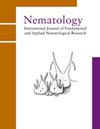Sachsia putridicola n. sp. (Rhabditida: Diplogastridae), isolated from an Onthophagus dung beetle (Coleoptera: Scarabaeidae) from Tsukuba, Japan
IF 1.2
4区 生物学
Q2 ZOOLOGY
引用次数: 0
Abstract
An undescribed Sachsia species (Diplogastridae) was isolated from a dung beetle, Onthophagus sp. cf. atripennis, and the species is described here as Sachsia putridicola n. sp. The new species is characterised by its cheilostom; anterior part forming a cuticular ring, posterior part in the form of a thin-walled tube; an anisotopic gymnostom, a metastegostom with dorsal small tooth and no subventral armature, and setiform male genital papillae with the arrangement . Sachsia putridicola n. sp. is typologically similar to two previously described congeners, Sachsia zurstrasseni and Sachsia postpapillata, but can be readily distinguished by its anisotopic gymnostom (vs isotopic gymnostom in the two nominal species) and the direction of the anterior three pairs of genital papillae, which are directed sublaterally in the new species (vs second or third pair directed sublaterally in S. zurstrasseni and S. postpapillata, respectively). Phylogenetically, the new species is close to Eudiplogasterium evidentum, not S. zurstrasseni. Based on the typological and phylogenetic characters, the status of S. zurstrasseni is discussed.Sachsia putridicola n. sp. (Rhabditida: Diplogastridae), isolated from an Onthophagus dung beetle (Coleoptera: Scarabaeidae) from Tsukuba, Japan
从一种蜣螂 Onthophagus sp.该新种的特征是:螯足;前部形成一个角质环,后部呈薄壁管状;异色的体螯,背侧有小齿而腹下无纟的元螯,以及排列成......的刚毛状雄性生殖器乳头。Sachsia putridicola n. sp.在类型学上与之前描述的两个同属种 Sachsia zurstrasseni 和 Sachsia postpapillata 相似,但很容易通过其异位体节(与这两个标称种的异位体节相比)和前三对生殖器乳头的方向进行区分,新种的生殖器乳头朝向近侧(与 S. zurstrasseni 和 S. postpapillata 分别朝向近侧的第二或第三对生殖器乳头相比)。在系统发育上,新种接近于 Eudiplogasterium evidentum,而不是 S. zurstrasseni。根据类型学和系统发育特征,讨论了 S. zurstrasseni 的地位。
本文章由计算机程序翻译,如有差异,请以英文原文为准。
求助全文
约1分钟内获得全文
求助全文
来源期刊

Nematology
生物-动物学
CiteScore
2.60
自引率
33.30%
发文量
67
审稿时长
3 months
期刊介绍:
Nematology is an international journal for the publication of all aspects of nematological research (with the exception of vertebrate parasitology), from molecular biology to field studies. Papers on nematode parasites of arthropods, and on soil free-living nematodes, and on interactions of these and other organisms, are particularly welcome. Research on fresh water and marine nematodes is also considered when the observations are of more general interest.
Nematology publishes full research papers, short communications, Forum articles (which permit an author to express a view on current or fundamental subjects), perspectives on nematology, and reviews of books and other media.
 求助内容:
求助内容: 应助结果提醒方式:
应助结果提醒方式:


